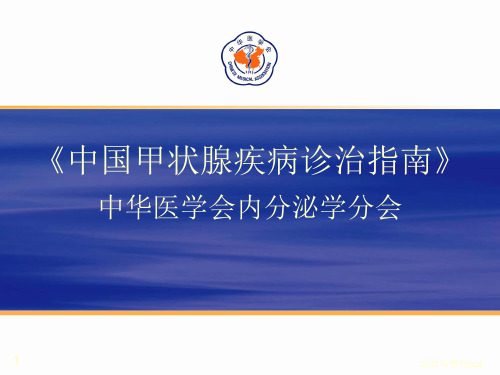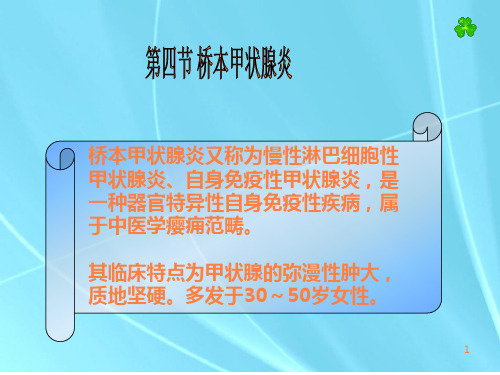
桥本甲状腺炎 Hashimoto Thyroiditis
.
1
内容提要
一、概述 二、诊断思路 三、治疗措施 四、预后 五、最新进展和展望
2
内容提要
一、概述 二、诊断思路 三、治疗措施 四、预后 五、最新进展和展望
3
概述
• 日本学者Hashimoto于1912年首先报道 • 又名:桥本病
Hashimoto disease 慢性淋巴细胞性甲状腺炎
11
病理
Pearce EN, Farwell AP, Braverman LE. Thyroiditis. N Engl J Med 2003;348:2646-2655.
8
流行病学
• HT是导致甲减的最常见病因,每年5%递增 • 女性多见,女性:男性 9-10:1 • 好发于30-50岁,产后、儿童 • 流行率:0.4-1.5%(中国) • 发病率:150/率增高 • 占甲状腺疾病的20-25%
chronic autoimmune thyroiditis
无痛性甲状腺炎 painless thyroiditis
产后甲状腺炎 postpartum thyroiditis
自身免疫性甲状腺炎 autoimmune thyroiditis
6
分型
特点
1型自身免疫 1A 有甲状腺肿
甲状腺功能正常促甲状腺激素(TSH)水平
Teng W, Shan Z, Teng X, et al.Effect of iodine intake on thyroid diseases in China. N Engl J Med. 2006, 354(26):2783-93.
10
Figure 1. The TAZ10 transgenic mouse model10 and the immunological basis for Hashimoto thyroiditis. (a) Thyroid follicle and the location of the major thyroid autoantigens: thyroid peroxidase (TPO), thyroglobulin (Tg) and the thyroid-stimulating hormone receptor (TSHR). (b) Immunological mechanisms leading to the spectrum of human autoimmunity with differing pathological and clinical characteristics. Graves hyperthyroidism is caused directly by TSHR autoantibodies that activate the TSHR. Hypothyroidism in Hashimoto thyroiditis is associated with autoantibodies to TPO (and less commonly to Tg), but the relative contributions to thyrocyte damage by autoantibodies, TPO-specific T cells and/or cytokines is unknown. The TAZ10 model of Quaratino et al. shows that TPO-specific T cells are sufficient to induce the histopathological and clinical features of Hashimoto disease. However, how CD8+ T cells and cytokines secreted by CD4+ T cells contribute to destruction has yet to be determined. T3, triiodothyronine.



